Deira
North of the Creek lies Deira, the second of the old city’s two principal districts, founded in 1841, when settlers from Bur Dubai crossed the Creek to establish a new village here. Deira rapidly overtook its older neighbour in commercial importance and remains notably more built-up and cosmopolitan than Bur Dubai, with a heady ethnic mix of Emiratis, Gulf Arabs, Iranians, Indians, Pakistanis and Somalis thronging its packed streets. Specific tourist attractions are thinner on the ground here than in Bur Dubai, but the district remains the best place in Dubai for aimless wandering, and even the shortest exploration will uncover a kaleidoscopic jumble of cultures, from Indian curry houses and Iranian grocers to Somali shisha-cafés and backstreet mosques – not to mention an endless array of shops selling everything from formal black abbeya to belly-dancing costumes.
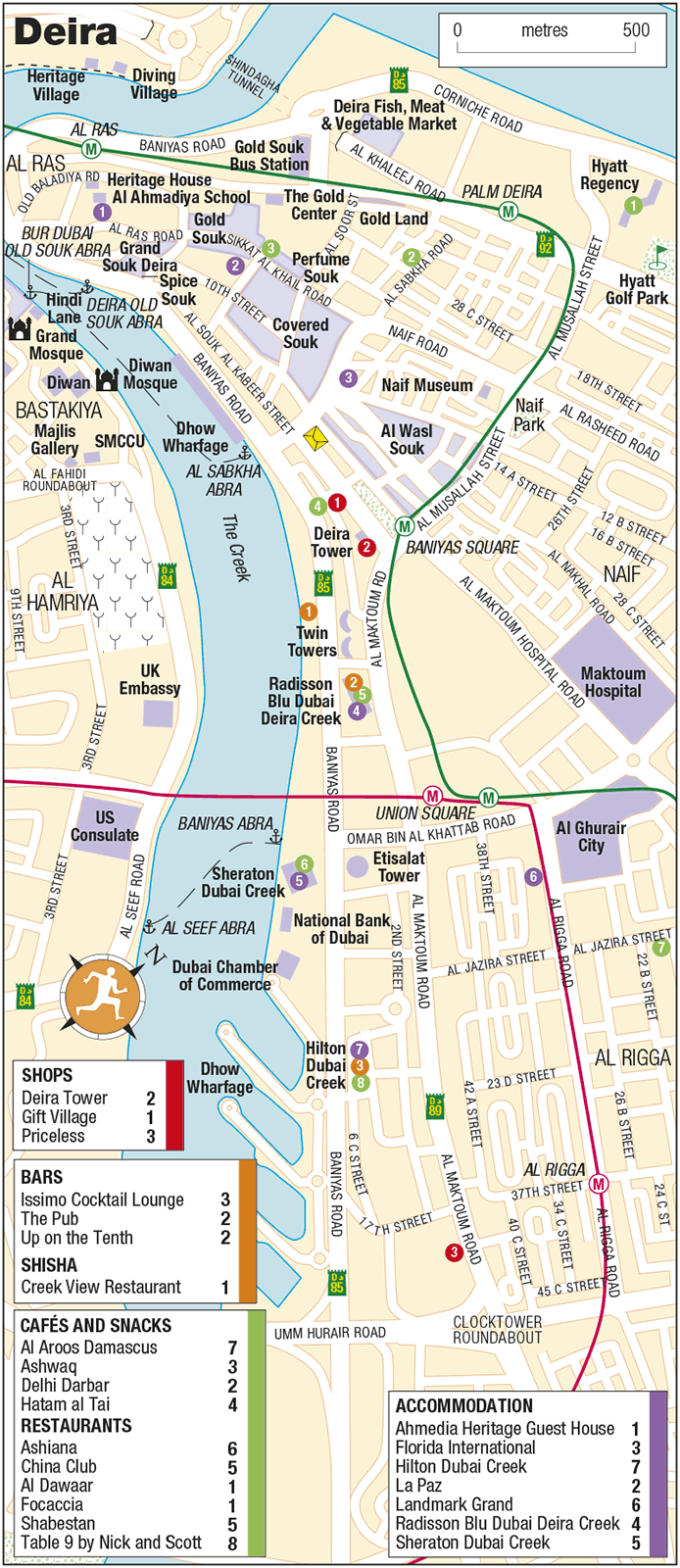
Gold Souk
Deira’s famous Gold Souk is usually the first stop for visitors to the district, with over three hundred shops lined up along its wooden-roofed main arcade, their windows packed with a staggering quantity of jewellery – it’s been estimated that there are usually around ten tonnes of gold here at any one time. The souk’s main attraction is price: the gold available here is among the cheapest in the world, and massive competition keeps prices keen. Though the gold industry in Dubai is carefully regulated, with the daily gold price fixed in all shops citywide, you should always bargain. A request for “best price” or “small discount” should yield an immediate discount of around 20–25 percent, although it always pays to shop around. The jewellery on offer ranges from restrained European-style pieces to ornate Arabian creations – the traditional Emirati bracelets, fashioned from solid gold and hung in long lines in shop windows, are particularly appealing.
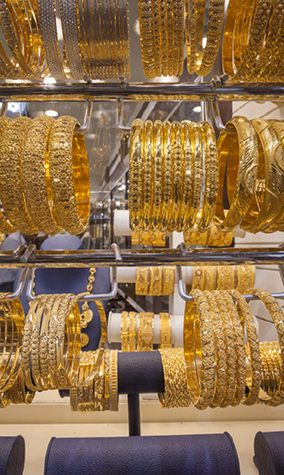
Heritage House
One of the city’s oldest museums, the engaging Heritage House offers the most complete picture of everyday life in old Dubai you’ll find anywhere in town. The building (originally constructed in 1890) is a classic example of a traditional Gulf mansion, with rooms arranged around a large sandy courtyard. Each of the rooms is enlivened with exhibits evoking aspects of traditional Emirati life, along with a large cast of elaborately dressed mannequins going about their daily business: drinking coffee, spinning thread, grinding spices and so on, while a couple of waxwork children look incuriously on.
Al Ahmadiya School
The Al Ahmadiya School is one of the city’s finest surviving examples of traditional Emirati architecture, and now houses an interesting museum devoted to the educational history of the emirate. Founded in 1912 by pearl merchant Sheikh Mohammed bin Ahmed bin Dalmouk, Al Ahmadiya was the first public school in UAE, and many of the city’s leaders studied here. It was also notably egalitarian – only the sons of wealthy families were expected to pay. Museum exhibits include old photos and the inevitable mannequins, including three tiny pupils being instructed by a rather irritable-looking teacher brandishing a wooden cane.
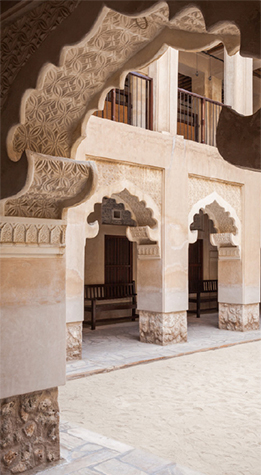
Grand Souk Deira
The extensive covered souk formerly known as Al Souk al Kabeer (“The Big Souk”) was once the largest and most important market in Deira. Now rechristened Grand Souk Deira, the whole area has recently been given a major makeover, although most of the shops remain rather dull. Easily the most interesting part of the souk is the diminutive Spice Souk (signed “Herbs Market”), perhaps the most atmospheric – and certainly the most fragrant – of the city’s many bazaars. Run almost exclusively by Iranian traders, the shops here stock a wide variety of culinary, medicinal and cosmetic products, with tubs of exotic merchandise set out in front of each tiny shopfront. The souk is particularly famous for its frankincense.
Dhow Wharfage
The Dhow Wharfage offers a fascinating glimpse into the maritime traditions of old Dubai. At any one time, it’s home to dozens of beautiful wooden dhows which berth here to load and unload cargo; hence the great tarpaulin-covered mounds of merchandise lying stacked up along the waterfront. The dhows themselves range in size from the fairly modest vessels employed for short hops up and down the coast to the large ocean-going craft used to transport goods around the Gulf and over to Iran, and even as far afield as Somalia, Pakistan and India. Virtually all of them fly the UAE flag, although they’re generally manned by foreign crews who live on board.
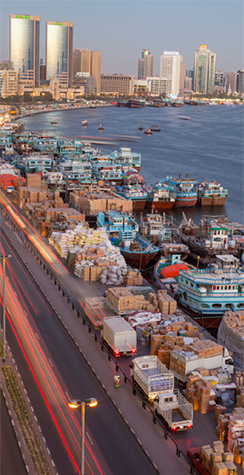
Perfume Souk
A string of stalls, mainly along Sikkat al Khail Road but also spilling on to Al Soor and Souk Seira streets, makes up the so-called Perfume Souk. Most places sell a mix of international brands (not necessarily genuine) along with the much heavier and more flowery oil-based attar perfumes favoured by local ladies. At many shops you can also create your own scents, mixing and matching from the contents of the big bottles lined up behind the counter before taking them away in chintzy little cut-glass containers, many of which are collectibles in their own right.
Deira Fish, Meat and Vegetable Market
The extensive Deira Fish, Meat and Vegetable Market occupies a large warehouse away from the hustle and bustle of central Deira; you can reach it by taking the footbridge over Al Khaleej Road opposite Gold Land shopping centre. The fruit and vegetable section features a photogenic array of stalls piled high with rambutans, mangosteens, coconuts, vast watermelons, yams and a bewildering array of dates in huge, sticky piles. The less colourful – and far more malodorous – fish section is stocked with long lines of sharks, tuna and all sorts of other piscine species right down to sardines. There’s also a small but rather gory meat section tucked away at the back.
Covered Souk
Deira’s sprawling Covered Souk (a misnomer, since it isn’t) comprises a rather indeterminate area of small shops arranged around the maze of narrow, pedestrianized alleyways which run south from Sikkat al Khail Road down towards the Creek. Most of the shops here are Indian-run, selling colourful, low-grade cloth for women’s clothes, along with large quantities of mass-produced plastic toys and cheap household goods. It’s all rather down-at-heel, but makes for an interesting stroll, especially in the area at the back of the Al Sabkha bus station, the densest and busiest part of the bazaar, particularly after dark – expect to get lost at least once. The souk then continues, more or less unabated, on the far side of Al Sabkha Road, where it’s known variously as the Naif Souk and Al Wasl Souk, before reaching Al Musallah Street.
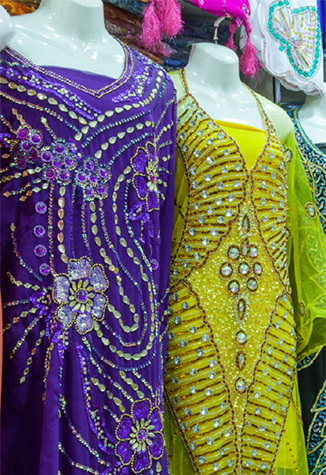
Naif Museum
Celebrating Dubai’s formidable reputation for law and order, the modest Naif Museum lies tucked away in a corner of the imposing Naif Fort (originally built in 1939, but restored to death in 1997). It’s actually a lot less tedious than you might fear, with mildly interesting exhibits on the history of law enforcement in the emirate from the foundation of the police force in 1956 (with just six officers under a British captain) up to the present day. Exhibits include assorted old weapons and uniforms, various old photos and a trio of short films including some interesting historical footage.
The National Bank of Dubai and around
Next to the Creek in the southern part of Deira you’ll find several of Dubai’s original modernist landmarks. Pride of place goes to the National Bank of Dubai building (1998), its Creek-facing side covered by an enormous, curved sheet of highly polished glass, modelled on the sail of a traditional dhow. Next to the bank sits the shorter and squatter Dubai Chamber of Commerce (1995), an austerely minimalist glass-clad structure which seems to have been designed using nothing but triangles, while nearby on Omar bin al Khattab Road stands the Etisalat Tower (1986), instantly recognizable thanks to the enormous golf ball on its roof.
Shops
Deira Tower
The so-called Deira Tower “Carpet Souk” comprises thirty-odd stores spread over two floors of a large office block. Stock ranges from huge, museum-quality Persian heirlooms to ghastly framed carpet pictures and other tat.
Gift Village
A veritable Aladdin’s cave of discounted everything, from pure tat through to designer desirables, including perfumes, electronics, clothing, bags, sports equipment, household appliances and cuddly toys.
Priceless
Worth the schlep for the excellent spread of top designer menswear and ladieswear – Armani, Yves Saint-Laurent, Gucci and the like – all sold at big discounts; two-thirds off label prices is standard.
Cafés and snacks
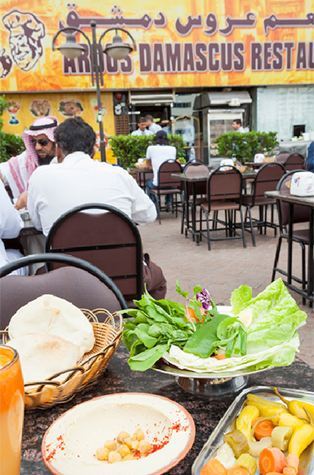
Al Aroos Damascus
One of a number of lively local Middle Eastern restaurants along Al Muraqqabat Road – Dubai’s “Little Iraq” – and parallel Al Rigga Road. All the usual Lebanese mezze and grills are on offer – well cooked, reasonably priced (mains from just 20dh) and served in huge portions.
Ashwaq
Close to the entrance to the bustling Gold Souk, this is one of the busiest and best of Deira’s various shwarma stands, with melt-in-the-mouth shwarma sandwiches (5dh) and big fruit juices (from 10dh).
Delhi Darbar
Unpretentious but excellent little no-frills restaurant serving up heartwarming meat kebabs, tandooris and Mughlai-style dishes (from 22dh) along with a good selection of veg curries (from 15dh) and superb tandoori rotis at just 1.50dh a pop.
Hatam al Tai
Bustling, no-frills café serving meaty and filling Iranian food – kebabs, stews, shwarma plates and biriyanis – at bargain prices (30–40dh). The shwarma stand outside is also good for a snack on the go.
Restaurants

Ashiana
Long-running but consistently popular Indian restaurant, offering an interesting selection of modern Indo-European fusion dishes (think tandoori lamb saddle or pan-fried duck in tamarind sauce) alongside a few old-school subcontinental classics. Live music at all meals. Mains 75–125dh.
China Club
The best Chinese restaurant in central Dubai, offering a daily “Yum Cha” buffet (99dh/person) at lunchtimes and à la carte in the evening, with well-prepared standards along with the restaurant’s signature dim sum (32–46dh) and Peking duck. Most mains 60–90dh.
Al Dawaar
Dubai’s only revolving restaurant, offering superlative city views. Food is buffet only (175dh at lunch; 235dh at dinner, excluding drinks), featuring a mix of international cuisine plus the restaurant’s signature US prime ribs – not the city’s greatest culinary experience, but a decent accompaniment to the head-turning vistas outside.
Focaccia
Rambling Italian restaurant with a casual ambience and soothing Gulf views. Food features a mix of traditional and modern Italian cuisine, with a seasonally changing menu and a mix of pasta and risottos (60–75dh), plus meat and fish mains (85–120dh).
Shabestan
This posh but rather plain Iranian restaurant retains a loyal following among Emiratis and expat Iranians thanks to its huge (if pricey) chelo kebabs, fish stews and other Persian specialities like baghalah polo (slow-cooked lamb) and zereshk polo (baked chicken with wild berries). Mains 95–135dh.
Table 9 by Nick and Scott
Top-notch modern European fine dining with an inventive menu that ranges from classics like pork belly and sea bass with cockles through to more quirky concoctions like duck with ceps and liquorice. You can mix and match “larger” (100dh) and “smaller” (80dh), while tasting menus are 300–450dh.
Bars
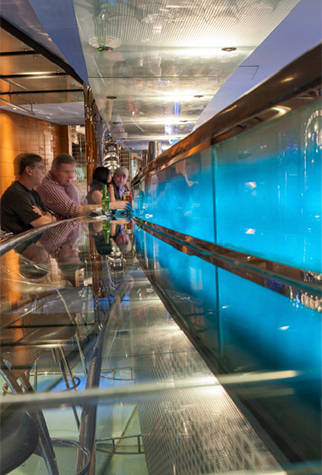
Issimo Cocktail Lounge
Chic little cocktail joint with a cute boat-shaped bar and a refreshingly unposey atmosphere – and also one of the city’s few non-smoking drinking holes. A good spot for an aperitif or digestif before or after a meal at Table 9 upstairs.
The Pub
Spacious and usually fairly peaceful English-style pub, complete with the usual fake wooden bar and lots of TVs screening global sports. Happy hour (20 percent discounts) daily 6–9pm.
Up on the Tenth
With its 80s-style decor this is not the most stylish venue in Dubai but it offers just about the best Creek views to be had in the city centre. Arrive early, grab a window seat and watch the city light up. A jazz singer and pianist perform daily (except Fri) from 10pm.
Shisha
Creek View Restaurant
This convivial little open-air café scores highly for its breezy creekside location and lively late-night atmosphere. It’s a good place for an after-dinner smoke (with ten types of shisha at 24–26dh) and coffee, although the food (mainly mezze and kebabs) is mediocre and the music cheesier than an Edam factory.